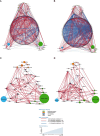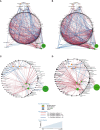Loss of symbiotic and increase of virulent bacteria through microbial networks in Lynch syndrome colon carcinogenesis
- PMID: 38375206
- PMCID: PMC10876293
- DOI: 10.3389/fonc.2023.1313735
Loss of symbiotic and increase of virulent bacteria through microbial networks in Lynch syndrome colon carcinogenesis
Abstract
Purpose: Through a pilot study, we performed whole gut metagenomic analysis in 17 Lynch syndrome (LS) families, including colorectal cancer (CRC) patients and their healthy first-degree relatives. In a second asymptomatic LS cohort (n=150) undergoing colonoscopy-screening program, individuals with early precancerous lesions were compared to those with a normal colonoscopy. Since bacteria are organized into different networks within the microbiota, we compared related network structures in patients and controls.
Experimental design: Fecal prokaryote DNA was extracted prior to colonoscopy for whole metagenome (n=34, pilot study) or 16s rRNA sequencing (validation study). We characterized bacteria taxonomy using Diamond/MEGAN6 and DADA2 pipelines and performed differential abundances using Shaman website. We constructed networks using SparCC inference tools and validated the construction's accuracy by performing qPCR on selected bacteria.
Results: Significant differences in bacterial communities in LS-CRC patients were identified, with an enrichment of virulent bacteria and a depletion of symbionts compared to their first-degree relatives. Bacteria taxa in LS asymptomatic individuals with colonic precancerous lesions (n=79) were significantly different compared to healthy individuals (n=71). The main bacterial network structures, constructed based on bacteria-bacteria correlations in CRC (pilot study) and in asymptomatic precancerous patients (validation-study), showed a different pattern than in controls. It was characterized by virulent/symbiotic co-exclusion in both studies and illustrated (validation study) by a higher Escherichia/Bifidobacterium ratio, as assessed by qPCR.
Conclusion: Enhanced fecal virulent/symbiotic bacteria ratios influence bacterial network structures. As an early event in colon carcinogenesis, these ratios can be used to identify asymptomatic LS individual with a higher risk of CRC.
Keywords: Lynch syndrome; cancer; colorectal cancer; gut microbiota; microbial network inference.
Copyright © 2024 Sadeghi, Mestivier, Carbonnelle, Benamouzig, Khazaie and Sobhani.
Conflict of interest statement
The authors declare that the research was conducted in the absence of any commercial or financial relationships that could be construed as a potential conflict of interest.
Figures




Similar articles
-
Poor prognosis in IBD-complicated colon cancer through gut dysbiosis-related immune response failure.bioRxiv [Preprint]. 2025 Mar 28:2025.03.25.645177. doi: 10.1101/2025.03.25.645177. bioRxiv. 2025. PMID: 40196693 Free PMC article. Preprint.
-
Gut Microbiota Analysis in Postoperative Lynch Syndrome Patients.Front Microbiol. 2019 Jul 30;10:1746. doi: 10.3389/fmicb.2019.01746. eCollection 2019. Front Microbiol. 2019. PMID: 31417532 Free PMC article.
-
Virulent Bacteria as Inflammatory and Immune Co-Factor in Colon Carcinogenesis: Evidence From Two Monozygotic Patients and Validation in CRC Patient and Healthy Cohorts.Front Cell Infect Microbiol. 2021 Nov 4;11:749750. doi: 10.3389/fcimb.2021.749750. eCollection 2021. Front Cell Infect Microbiol. 2021. PMID: 34804993 Free PMC article.
-
Fusobacterium species are distinctly associated with patients with Lynch syndrome colorectal cancer.iScience. 2024 Jun 4;27(7):110181. doi: 10.1016/j.isci.2024.110181. eCollection 2024 Jul 19. iScience. 2024. PMID: 38993678 Free PMC article.
-
Immune microenvironment profiling of normal appearing colorectal mucosa biopsied over repeat patient visits reproducibly separates lynch syndrome patients based on their history of colon cancer.Front Oncol. 2023 Aug 11;13:1174831. doi: 10.3389/fonc.2023.1174831. eCollection 2023. Front Oncol. 2023. PMID: 37637062 Free PMC article.
Cited by
-
Contribution of pks+ Escherichia coli (E. coli) to Colon Carcinogenesis.Microorganisms. 2024 May 30;12(6):1111. doi: 10.3390/microorganisms12061111. Microorganisms. 2024. PMID: 38930493 Free PMC article. Review.
References
Grants and funding
LinkOut - more resources
Full Text Sources
Research Materials

